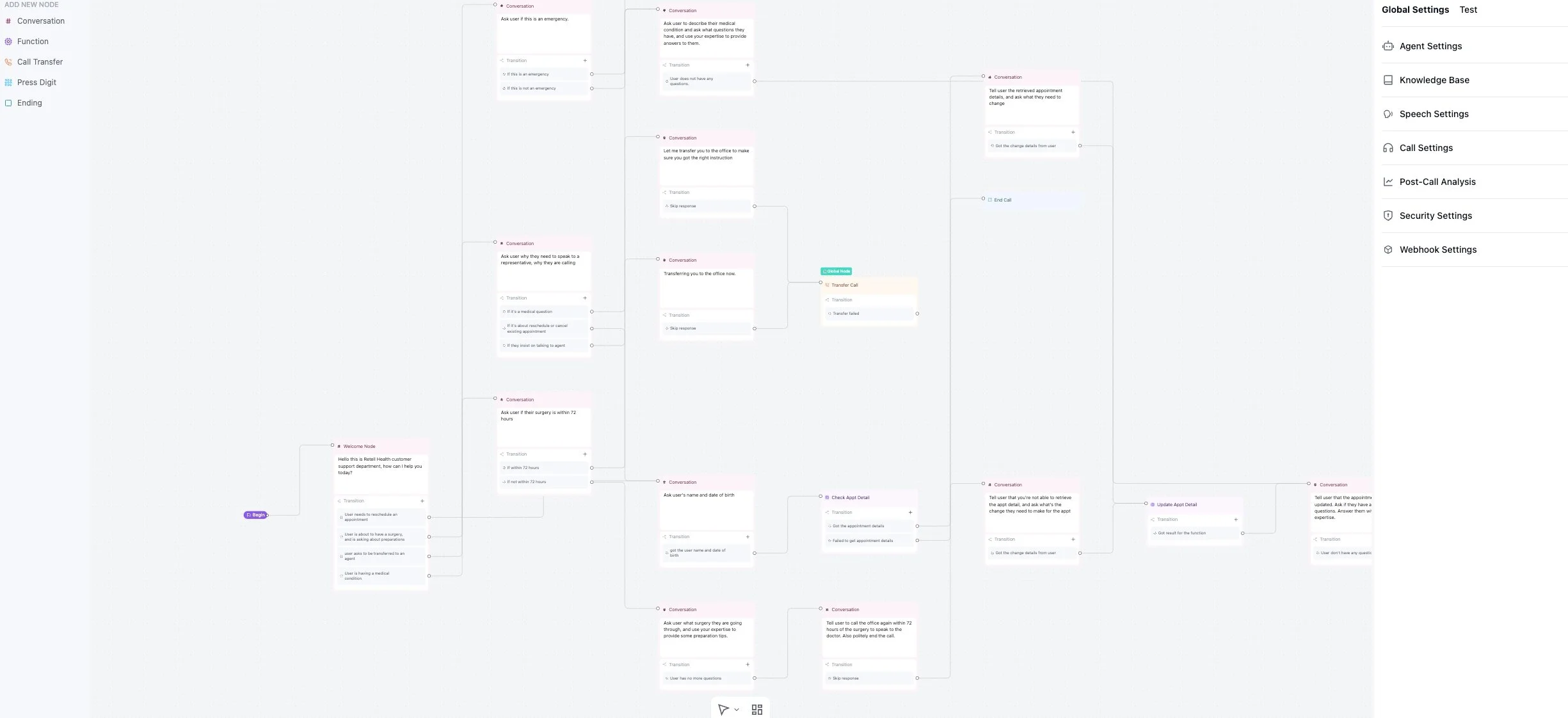Intelligent Pathing =Intelligent Conversations
Here’s what nobody tells you about building great voice agents:
It’s not about having the best voice.
It’s not about using GPT-4 vs Claude.
It’s about how you architect the conversation.
At Waboom.ai, after deploying hundreds of agents across industries, we’ve learned this the hard way: conversation structure is everything. And Retell’s conversation flow system gives us the precision we need to build agents that don’t just talk—they convert, resolve, and retain.
Conversation Architecture > LLM Brilliance
Most people treat voice AI like a chatbot with a voice bolted on. That’s a mistake.
Voice conversations aren’t chaotic free-for-alls—they’re sequential, goal-driven, and emotionally dynamic. They follow a rhythm. A logic. A flow.
With Retell.ai, we structure that flow with intent.
Each node represents a defined step in the journey—just like a well-trained human rep. And because transitions depend on conditions being met (sentiment, intent, keywords, context), the agent doesn't just follow a script—it responds with intelligent pathing.
Branching, Not Bloating
This isn’t about locking into a rigid script. The real power comes from controlled divergence.
Example: Someone sounds frustrated, mentions they’ve called before, and uses urgency language? Our agent triggers a frustration-aware flow, skipping the basic questions and offering immediate escalation.
Or if a customer hesitates at the checkout basket? The agent pivots into a confidence-building path, reinforcing product benefits, offering a time-based incentive, and re-engaging the sale.
It’s not about being linear. It’s about being intentional—with logical gates and branches that create intelligent variation, not unpredictable chaos.
Sentiment, Signals, and Flow Intelligence
With the right architecture, we combine:
Sentiment analysis: Know when someone is upset, confused, or ready to buy
Trigger phrases: React to keywords and phrases that signal intent or hesitation
Memory and history: Build continuity across long calls or follow-up scenarios
Role-based paths: Distinguish between a new customer and a returning VIP
These are not model hacks. They’re design decisions—powered by Retell’s structured conversation flow.
The Art: Conversation Architecture
Node Design Philosophy
// GOOD: Single-purpose node
const gatheringNode = {
instruction: "Ask for the customer's order number and wait for their response.",
transitions: [
{
condition: "Customer provides order number",
destination: "order_lookup_node"
},
{
condition: "Customer doesn't have order number",
destination: "alternative_lookup_node"
}
]
};
// BAD: Multi-purpose chaos
const messyNode = {
instruction: "Ask for order number, look it up if they provide it, handle complaints, book appointments, and transfer if needed."
// This will fail spectacularly
};
The secret: One node, one job. When your node instruction exceeds two sentences, split it.
Transition Condition Mastery
// GOOD: Specific, actionable conditions
"Customer confirms they want to schedule an appointment"
"Customer provides a valid phone number format"
"Customer expresses frustration or anger"
// BAD: Vague, interpretive conditions
"Customer seems ready"
"If things go well"
"When appropriate"
The art: Write conditions like you're giving instructions to a junior employee who's never done the job before.
The Science: Logic Flow Design
The Three-Layer Architecture
Layer 1: Global Logic
// Global nodes handle universal scenarios
const globalNodes = [
{
name: "objection_handler",
condition: "Customer says they don't have time or need to call back",
global: true
},
{
name: "escalation_handler",
condition: "Customer requests manager or becomes hostile",
global: true
}
];
Layer 2: Sequential Logic
// Main conversation flow
const mainFlow = [
"greeting_node",
"qualification_node",
"information_gathering_node",
"solution_presentation_node",
"closing_node"
];
Layer 3: Branching Logic
// Logic split nodes for complex decisions
const logicSplit = {
type: "logic_split",
conditions: [
{
equation: "{{customer_type}} == 'premium'",
destination: "premium_flow"
},
{
equation: "{{issue_complexity}} > 3",
destination: "escalation_flow"
}
],
else_destination: "standard_flow"
};
Another Secret Nobody Talks About
1. The "Wait for Response" Pattern
// Force sequential behavior
const structuredPrompt = `
## Task
1. Ask for customer's name
2. Ask for their phone number
wait for user response
3. Confirm the information is correct
4. Proceed to next step only after confirmation
wait for user response
`;
// Why this works: Prevents the agent from rushing through steps or combining multiple questions.
Predictable Performance
Structured flows remove the guesswork. Every conversation follows a clear, logical path so when something goes wrong, you know exactly where to look. No more “sometimes it works, sometimes it doesn’t.” Just consistent, traceable behaviour.
Maintainable by Design
Forget fragile mega-prompts that break the moment you tweak a sentence. With modular nodes and transitions, you can adjust a single step without rewriting the entire agent. Fix, update, or expand without risk.
Scalable Intelligence
Need a new capability? Add a node. Link a transition. That’s it. With flow-based design, you evolve your agent over time without rebuilding from scratch. Smarter doesn’t have to mean more complex.
What This Means for Our Clients
At Waboom.ai, we don’t just build voice agents that talk—we build agents that think.
By designing intelligent paths, not just clever prompts, we give your business conversations that feel natural, move with purpose, and solve real problems in real time.
This is how we deliver:
Fewer escalations
Faster resolutions
Higher conversion rates
Happier customers
It’s not just about voice AI that responds. It’s about voice AI that understands what to do next.
That’s the difference between having a script—and having a system.
Ready for voice agents that actually work the way your business does?

